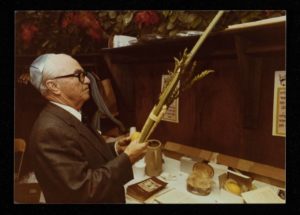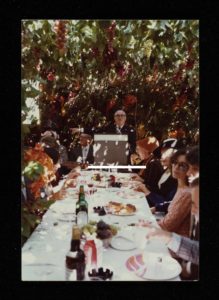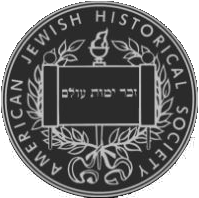Searching for Meaning, Finding Inspiration
A Guest Post from the Vilna Shul, Boston’s Center for Jewish Culture Visitors reading about the exhibit honoring the 50th anniversary of Sukkah in the Sky.
Visitors reading about the exhibit honoring the 50th anniversary of Sukkah in the Sky.
Excerpts from the Come to the Sukkah exhibit are italicized throughout the article.
Quiet anticipation. As my colleague and I enter the room, my eyes dart to the gray boxes carefully stacked behind the desk at the American Jewish Historical Society.
Box 2, Folder 7 – Contents unclear
Box 4, Folder 5 – Newspaper clippings (1982) and Folder 13 – Invitations (1972-1985)
Box 8, Folders 5 and 6 – Photographs (1972-1991)
Museum Box 25, Object 2020.001.060- Unclear
After a month of planning that involved a flurry of emails stretching 46 messages long, a brief Zoom conversation, and several internal meetings, the day we’d been waiting for had finally arrived. Each of us diligently put on gloves, a surgical mask, and carefully placed our clear bag containing a cell phone, pencil, and photo ID on a table in the far corner of The Lillian Goldman Reading Room. With a keen desire to “find the story,” Dalit Ballen Horn, Executive Director of The Vilna Shul, Boston’s Center for Jewish Culture, and I requested the first of our four boxes from the Jack D. Weiler and Family Papers.
With only eight hours to capture the essence of Jack D. Weiler, a man who seemed larger than life, and the “Sukkah in the Sky,” his ambitious endeavor built atop the W.R. Grace Building in New York City, we knew we had to focus intently to find the angle hidden within the archives. At first, one of us would open a folder and carefully read the next document in its entirety and ask, “Are you done? Should I pull out the next one?” This method quickly became inefficient as the first hour flew by.

Shifting gears, we each slid a folder out of the box and began sifting through myriad primary sources – each more interesting than the last. Newspaper clippings. Hand-typed letters. Telegrams. Invitations. Cabinet Card photographs from the turn of the 20th century. 8”X10” Black and white photos from the 1960’s. Polaroids from the 1970’s. As we studied each item, the life of Weiler began to come into focus.
An early 20th Century American Jewish Immigrant
In 1910, the Weiler family boarded a ship
for New York City seeking religious freedom and a new life.
Jack D. Weiler was four years old and one of ten children.
His family lived in a small tenement apartment
among scores of new Jewish immigrants
with shared histories and aspirations.
When his family could no longer afford his college tuition,
Jack accepted a job as a stenographer in a real estate office.
Eventually he became a real estate broker.
In 1936, he partnered with Benjamin Swig of Boston
and founded Swig & Weiler, national real estate business.
With over five million square feet in New York City,
properties included the original Metropolitan Opera House
and the W. R. Grace Building
One box contained correspondence and invitations related to Sukkah in the Sky. He gathered world leaders, business partners, family, and friends to celebrate the weeklong harvest holiday of Sukkot.
“All of us at the JDC look forward to these annual gatherings with great anticipation. It is one of the hottest tickets in town. With our renewed inspiration of the New Year still intact, we gather here for a celebration that is at once religious and traditional and intimate and social, something that is ours.” – Ralph I. Goldman, Executive Vice President, Joint Distribution Committee
“Your idea of constructing this Sukkah is superb. It is now a national institution serving both body and spirit – philanthropy and tradition – of the Jewish people.” – Aaron Greenbaum
“This succah is becoming such a fixture in New York and so much a part of Jewish life here that some of my so-called friends have accused me of putting up this building just so I would be able to build this succah every year.” – Jack D. Weiler
The magnitude of the process of erecting a sukkah atop a skyscraper is preserved in the newspaper clippings from the inaugural event in 1972. This innovative tradition became one of the most inspiring and joyous Jewish activities in New York City.
“According to many who participated in the week-long festivities in the sukkah, it was the only tabernacle on the roof of any commercial building in this city and possibly the entire country. It took eight construction workers one week to build the handsome, sturdy tabernacle which was profusely decorated with grapes, lulavs, esrogs and other fruits of the field, vineyard and orchards in a manner traditional since Biblical days.” – From “Sukkah in the Sky” article, Jewish Telegraphic Agency (JTA), Murray Zuckoff, JTA News Editor, October 2, 1972
“Many of those who came here during the week hadn’t been in a sukkah for maybe thirty, forty years. Some hadn’t been in a sukkah at all. For many, it was a reaffirmation of their Jewish faith, a re-dedication of the spirit of Jewishness. For some, it was the first time that they felt like Jews.” – Jack Weiler quoted in “Sukkah in the Sky” article, Jewish Telegraphic Agency (JTA), Murray Zuckoff, JTA News Editor, October 2, 1972

However, the most revealing sources in the archives by far were the little handwritten notes Jack jotted down on whatever piece of paper he had in the moment. Half a sheet of paper. A napkin. A few sheets from a hotel monogrammed pad. A quote. An idea. A memory. A speech. Some words scribbled out. Some words in all caps. Others appearing only in the margins of the page.
With each thought – both large and small – preserved in the archives, the wit and the “why” behind the man and his success in bringing people together jumped off the page.
“One of my biggest pleasures is Sukkah in the Sky. It’s a time when I feel like my family is so big, every Jew is part of it.” – Jack D. Weiler
“I want to welcome you all once again to the Sukkah in the Sky. It’s now about five years since we started to hold these Sukkoth celebrations here in the clouds and I can’t think of anything that has given me – and I’m sure most of you – so much pleasure. This building isn’t Mount Sinai but it’s taller. If Moses could talk to G-d from Mount Sinai, we can talk to him from here; we’re much closer.” – Jack D. Weiler
Jewish Community and Shared Responsibility
Jack used his fortune and fame to inspire
the first generation of Jewish business leaders
to think and act philanthropically. For decades,
Weiler served in leadership roles at organizations
to advance intra-Jewish dialogue, protect civil and religious liberties,
and invest in the future of the state of Israel.
Jack inspired immigrants to volunteer
their time and invest financial resources in creating
a strong and vibrant Jewish community in America.

The holiday of Sukkot is an eight-day festival centering on two events: the Israelites’ exodus from Egypt followed by 40 years of wandering before reaching the land of Israel and the agricultural harvest of grain and other essential crops.
These two events encourage us to grapple with contemporary paradigms of the impermanent nature of our world, and our responsibility to safeguard and celebrate the land we inhabit and the joy and nourishment it provides us.
The Vilna Shul, Boston’s Center for Jewish Culture, is the fulcrum for Jewish culture and engagement in downtown Boston. We celebrate Jewish culture, heritage, and values through arts and entertainment, holiday celebrations, and adult learning. We seek to be a radically welcoming and inclusive space for Boston’s diverse adult populations to engage in Jewish life.
Through concerts, author talks, film screenings, art exhibits, museum tours, adult learning and more, The Vilna gives voice and meaning to the histories and experiences of Boston’s immigrants and newcomers.
We are deeply grateful for the support of Jack D. Weiler’s granddaughter. In choosing The Vilna as a place to honor the 50th anniversary of Sukkah in the Sky, we were able to dream big and inspire others. Weiler embodied the true spirit of Sukkot by welcoming people from all corners of the earth to rejoice and find meaning in the Sukkah he built atop the W. R. Grace Building in New York City. At The Vilna, hundreds of people joined us in celebrating the holiday of Sukkot. During the weeklong celebration, we hosted five events and welcomed a wide range of guests. Come to the Sukkah was our first exhibit held in our newly renovated community room. This exhibit was made possible by the archival collection at the American Jewish Historical Society.
In closing, I’d like to end with a quote from the Weiler files that still brings me to tears every time I read it.
“The bricks and mortar will outlast me and my children. But the work I was privileged to be part of will be written down in the living history of our people. I would sooner be a footnote in the glorious pages of Jewish history than a dim memory in the ruins of a dozen buildings.” – Jack D. Weiler


